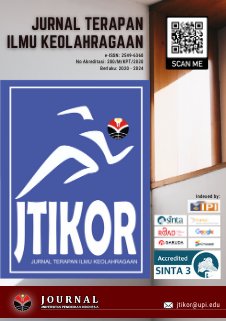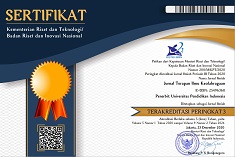Physical Self-Concept dan Body Mass Index: Hubungan dan Perbedaan berdasarkan Gender
Abstract
Penelitian ini bertujuan untuk mengkaji hubungan antara Physical Self-Concept (PSC)dengan Body Mass Index (BMI)serta perbedaan PSC dan BMI berdasarkan gender. Metode yang digunakan pada penelitian ini adalah assosiasonal (correlational dan kausal-komparatif). Sample berjumlah 59 orang siswa remaja SMA di Kabupaten Ciamis. Instrument yang digunakan untuk mengukur PSC adalah Physical Self Description Questionnaire (PSDQ). Untuk menguji hubungan antara PSC dan BMI digunakan koefisien korelasi, dan untuk uji beda digunakan independent sample t-test. Hasil pengolahan dan analisis menunjukan bahwa, (1) tidak ada hubungan yang signifikan antara PSC dan BMI (p > 0.05); (2) tidak terdapat perbedaan BMI yang signifikan antara laki-laki dan perempuan (p > 0.05); (3) terdapat perbedaan PSC yang signifikan antara laki-laki dan perempuan (p < 0.05).
This study aims to examine the relationship between Physical Self-Concept (PSC) and Body Mass Index (BMI) and differences in PSC and BMI based on gender. The method used in this study is associational (correlational and causal-comparative). Sample amounted to 59 high school teenagers in Ciamis Regency. The instrument used to measure PSC is Physical Self Description Questionnaire (PSDQ). To test the relationship between PSC and BMI used the correlation coefficient, and for the different tests used independent sample t-test. The results of processing and analysis show that, (1) there is no significant relationship between PSC and BMI (p> 0.05); (2) there was no significant difference in BMI between men and women (p> 0.05); (3) there are significant differences in PSC between men and women (p <0.05).
Keywords
Full Text:
PDFReferences
Aires, L. et al. 2010. “A 3-Year Longitudinal Analysis of Changes in Body Mass Index.” International Journal of Sports Medicine 31(2): 133–37.
Bays, H E, R H Chapman, S Grandy, and Investigators Group. 2007. “The Relationship of Body Mass Index to Diabetes Mellitus , Hypertension and Dyslipidaemia : Comparison of Data from Two National Surveys.” (May): 737–47.
Bps, Katalog. 2013. Proyeksi Penduduk Indonesia Indonesia. Jakarta: Badan Pusat Statistik.
Caglar, Emine. 2015. “Similarities and Differences in Physical Self-Concept of Males and Females during Late Adolescence and Early Adulthood SIMILARrnES AND DIFFERENCES IN PHYSICAL SELF- CONCEPT OF MALES AND FEMALES DURING LATE ADOLESCENCE AND EARLY ADULTHOOD Emine Çaglar.” (June 2009).
Calle, Eugenia E. et al. 1999. “BODY-MASS INDEX AND MORTALITY IN A PROSPECTIVE COHORT.” : 1097–1105.
Dishman, Rod K et al. 2006. “Physical Self-Concept and Self-Esteem Mediate Cross-Sectional Relations of Physical Activity and Sport Participation With Depression Symptoms Among Adolescent Girls.” 25(3): 396–407.
Fernández-bustos, Juan Gregorio. 2019. “Effect of Physical Activity on Self-Concept : Theoretical Model on the Mediation of Body Image and Physical Self-Concept in Adolescents.” 10(July).
Gomez-baya, Diego, Ramon Mendoza, and Margarida Gaspar De Matos. 2017. “Sport Participation , Body Satisfaction and Depressive Symptoms in Adolescence : A Moderated-Mediation Analysis of Gender Differences.” European Journal of Developmental Psychology 5629(September): 0. https://doi.org/10.1080/17405629.2017.1364988.
Jack R. Fraenkel,. Norman E. Wallen, Helen H. Hyun. 2007. 136 Journal of Experimental Psychology: General HOW TO DESIGN AND EVALUATE RESEARCH IN EDUCATION.
Jacobs, Janis E. et al. 2002. “Changes in Children’s Self-Competence and Values: Gender and Domain Differences across Grades One through Twelve.” Child Development 73(2): 509–27.
Jekauc, Darko et al. 2017. “Does Physical Self-Concept Mediate the Relationship between Motor Abilities and Physical Activity in Adolescents and Young Adults ?” : 1–18.
Jesús, María, and Cava Caballero. 1998. “LA POTENCIACIÓN DE LA AUTOESTIMA.”
Kemenkes, Badan Penelitian dan Pengembangan Kesehatan. 2018. HASIL UTAMA RISKESDAS 2018.
Kim, Hyunsook. 2018. “The Effect of Physical Self-Concept on Sportswear Dependence and Psychological Happiness Hyunsook.” Journal of the Korean Society of Clothing and Textiles 42(6): 1039–55.
Konowalczyk, Svenja, F Clemens A Rade, and Zena R Mello. 2019. “Time Perspective , Sports Club Membership , and Physical Self- Concept among Adolescents : A Person-Centered Approach.” Journal of Adolescence 72(July 2018): 141–51. https://doi.org/10.1016/j.adolescence.2019.02.008.
Marsh, Herbert W. 2010. “Introducing A Short Version of the Physical Self Description Questionnaire.” : 438–82.
Martín-Albo, José et al. 2012. “Relationships between Intrinsic Motivation, Physical Self-Concept and Satisfaction with Life: A Longitudinal Study.” Journal of Sports Sciences 30(4): 337–47.
Ortega, F. B., J. R. Ruiz, M. J. Castillo, and M. Sjöström. 2008. “Physical Fitness in Childhood and Adolescence: A Powerful Marker of Health.” International Journal of Obesity 32(1): 1–11.
Romero-Corral, A. et al. 2008. “Accuracy of Body Mass Index in Diagnosing Obesity in the Adult General Population.” International Journal of Obesity 32(6): 959–66.
Schwimmer, Jeffrey B, Tasha M Burwinkle, and James W Varni. 2015. “Health-Related Quality of Life of Severely Obese Children and Adolescents.” 289(14): 1813–19.
Shiomori, Teruo, Shin ichi Yoshida, Hiroshi Miyamoto, and Kazumi Makishima. 2000. “Physical Self-Concept and Sports: Do Gender Differences Still Exist?” Journal of Allergy and Clinical Immunology 105(3): 449–54.
Teixeira, Pedro J. et al. 2012. “Motivation, Self-Determination, and Long-Term Weight Control.” International Journal of Behavioral Nutrition and Physical Activity 9(1): 22. http://www.ijbnpa.org/content/9/1/22.
Tóth, László et al. 2019. “Original Article Exercise Involvement and Trait-Anxiety Are Determinants of Physical Self-Concept : Exercisers Exhibit Superior Profiles Compared with Non-Exercisers.” 19(1): 580–85.
Zsakai, Annamaria, Zsolt Karkus, Katinka Utczas, and Eva B Bodzsar. 2015. “Body Structure and Physical Self-Concept in Early Adolescence.”
DOI: https://doi.org/10.17509/jtikor.v4i2.19016
Refbacks
- There are currently no refbacks.
Copyright (c) 2020 Jurnal Terapan Ilmu Keolahragaan

This work is licensed under a Creative Commons Attribution-NonCommercial-ShareAlike 4.0 International License.





